
Northern Rail, branded as Northern, was an English train operating company owned by Serco-Abellio that operated the Northern Rail franchise from 2004 until 2016. It was the primary passenger train operator in Northern England, and operated the most stations of any train operating company in the United Kingdom. Northern Rail was replaced on 1 April 2016 by Arriva Rail North.

The Cumbrian Coast line is a rail route in North West England, running from Carlisle to Barrow-in-Furness via Workington and Whitehaven. The line forms part of Network Rail route NW 4033, which continues via Ulverston and Grange-over-Sands to Carnforth, where it connects with the West Coast Main Line.
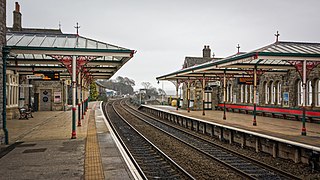
Grange-over-Sands is a railway station on the Furness Line, which runs between Barrow-in-Furness and Lancaster. The station, situated 15+1⁄2 miles (25 km) north-west of Lancaster, serves the town of Grange-over-Sands in Cumbria. It is owned by Network Rail and managed by Northern Trains.

Barrow-in-Furness is a railway station on the Cumbrian Coast Line and Furness Line, 85+1⁄2 miles (138 km) south-west of Carlisle and 34+3⁄4 miles (56 km) north-west of Lancaster, in the town of Barrow-in-Furness, Cumbria. It is owned by Network Rail and managed by Northern Trains.
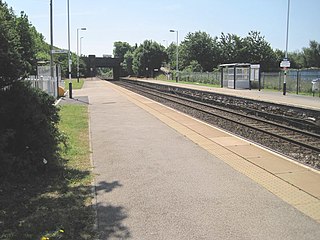
Roose is a railway station on the Furness Line, which runs between Barrow-in-Furness and Lancaster. The station, situated 1+3⁄4 miles (3 km) east of Barrow-in-Furness, serves the suburb of Roose in Barrow-in-Furness, Cumbria. It is owned by Network Rail and managed by Northern Trains.

Lancaster railway station is a railway station that serves the city of Lancaster in Lancashire, England. It is one of the principal stations on the West Coast Main Line. It is located 20 miles 78 chains (33.76 km) from Preston and is the zero point for mileages onward to Carlisle.
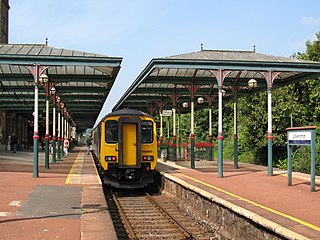
Ulverston is a railway station on the Furness Line, which runs between Barrow-in-Furness and Lancaster. The station, situated 9+1⁄2 miles (15 km) north-east of Barrow-in-Furness, serves the market town of Ulverston in Cumbria. It is owned by Network Rail and managed by Northern Trains.

Dalton is a railway station on the Furness Line, which serves the town of Dalton-in-Furness in Cumbria, England. It is owned by Network Rail and managed by Northern Trains.
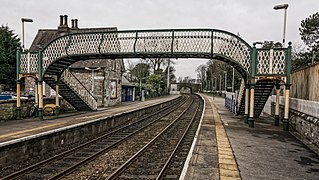
Cark & Cartmel is a railway station on the Furness line, which runs between Barrow-in-Furness and Lancaster. The station, situated 15+1⁄4 miles (25 km) north-east of Barrow-in-Furness, serves the villages of Allithwaite, Cark, Cartmel and Flookburgh in Cumbria. It is owned by Network Rail and managed by Northern Trains.
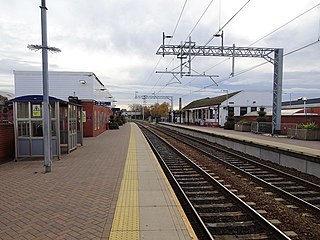
Chorley railway station serves the town of Chorley in Lancashire, England. Since 2004 it has been linked with Chorley Interchange bus and coach station. It is on the Manchester–Preston line.

Wigan North Western railway station is one of two railway stations serving the town centre of Wigan, Greater Manchester, England.

The Manchester–Preston line runs from the city of Manchester to Preston, Lancashire, England. It is largely used by commuters entering Manchester from surrounding suburbs and cities, but is also one of the main railway lines in the North West and is utilised by TransPennine Express regional services and to Scotland. It was announced in December 2009 that the line would be electrified, following an announcement in July 2009 that the Chat Moss line between Manchester and Liverpool was to be electrified first. The electrification work for this line commenced in May 2015 and was due for completion in May 2018, but was delayed until December 2018.

Aspatria railway station is a railway station serving the town of Aspatria in Cumbria, England. It is on the Cumbrian Coast Line, which runs between Carlisle and Barrow-in-Furness. It is owned by Network Rail and managed by Northern Trains.

Wigton railway station is a railway station serving the market town of Wigton in Cumbria, England. It is on the Cumbrian Coast Line, which runs between Carlisle and Barrow-in-Furness. It is owned by Network Rail and managed by Northern Trains.
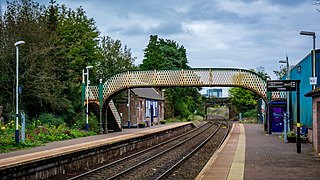
Dalston railway station serves the village of Dalston near Carlisle in Cumbria, England. It is on the Cumbrian Coast Line, which runs between Carlisle and Barrow-in-Furness. It is owned by Network Rail and managed by Northern Trains.

Manchester Airport station is a railway, tram, bus and coach station at Manchester Airport, England which opened at the same time as the second air terminal in 1993. The station is 9+3⁄4 miles (15.7 km) south of Manchester Piccadilly, at the end of a short branch from the Styal line via a triangular junction between Heald Green and Styal stations. Manchester Metrolink tram services were extended to the airport in 2014 and operate to Manchester Victoria.

Penrith North Lakes is a railway station on the West Coast Main Line, which runs between London Euston and Edinburgh Waverley or Glasgow Central. The station, situated 17 miles 69 chains (28.7 km) south of Carlisle, serves the market town of Penrith, Westmorland and Furness in Cumbria, England. It is owned by Network Rail and managed by Avanti West Coast.

First TransPennine Express was a British train operating company jointly owned by FirstGroup and Keolis which operated the TransPennine Express franchise. First TransPennine Express ran regular Express regional railway services between the major cities of Northern England as well as Scotland.

TransPennine Express (TPE), legally First TransPennine Express Limited, was a British train operating company owned by FirstGroup that operated the TransPennine Express franchise. It ran regional and inter-city rail services between the major cities and towns of Northern England and Scotland.

Arriva Rail North, branded as Northern by Arriva, was a train operating company in Northern England which began operating the Northern franchise on 1 April 2016 and inherited units from the previous operator Northern Rail. A subsidiary of Arriva UK Trains, Northern was the largest train franchise in the United Kingdom in terms of the size of the network and the number of weekly services run. Its trains called at 528 stations, about a quarter of all stations in the country; of these stations 476 were operated by Northern. On 1 March 2020, Arriva Rail North Limited ceased to operate and all operations were handed to HM Government's Operator of Last Resort.























